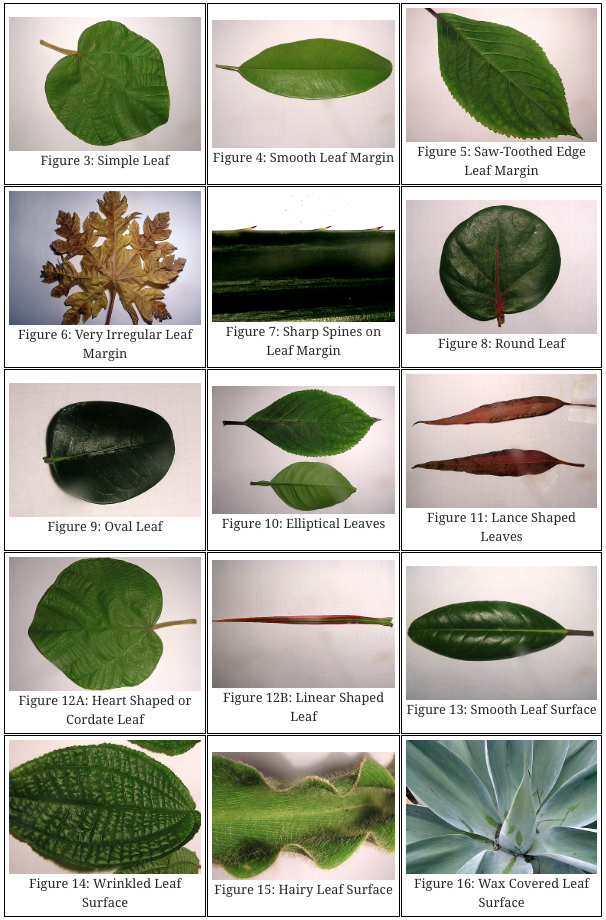Simple Leaves
The flat, light-intercepting part of a leaf is called the blade. It may be directly attached to a stem at its base, or, the blade may be attached to the stem by a narrow stalk called a petiole. There is almost always a bud (tiny growing point) found in the angle between the petiole and the stem (leaf axil). A simple leaf (Figure 3) consists of one blade and (usually) a petiole that connects the blade to the stem.
The edge of the leaf blade is called the leaf blade margin. There are many different types of leaf margins. A few examples include: Smooth (Figure 4), Saw-Toothed (serrate—Figure 5), very Irregular (Figure 6), and even Armed with sharp spines (Figure 7).
The leaf blade typically has a characteristic shape or form, e.g. Round (Figure 8), Oval (Figure 9), Elliptical (Figure 10), Lance (Figure 11), Heart/Cordate (Figure 12A), or Linear (Figure 12B). The leaf surface may be smooth (Figure 13), or wrinkled/rugose (Figure 14), or covered with hairs (pubescent/tomentose, Figure 15) or wax (glaucous, Figure 16).

Water and mineral nutrients from the soil are moved about in the leaf blade through “veins”, which are usually in patterns characteristic of the particular plant from which the leaf was taken. Three major venation patterns in simple leaves are “palmate”, “pinnate”, or “parallel” (Figure 17, left to right).

Typically there is a prominent central vein (the midrib) running from the leaf base to its tip. In broadleaf plants (Dicots) there are typically many smaller veins that originate from both sides of the midrib and spread outwards towards the leaf margin in a pattern similar to that exhibited by the feather of a bird. This is called pinnate venation. The leaf of a Breadfruit Tree (Figure 18) is a pinnately veined leaf, as is the leaf of Croton (Figure 19). If there are several large veins in a leaf and they all originate at the leaf base, then the venation pattern is called palmate (Figure 20). (This is in reference to the fingers of our hands originating from one place—the palm.) The leaf of the Kukui Nut Tree shown to the left in Figure 20 has palmate venation.
Narrow-leaf plants (Monocots) produce leaves with parallel venation—typically running parallel to the midrib along the whole length of the usually linear leaf (Figure 21).

The location on the stem where the leaf is attached is called a “node”. There may be just one leaf per node—the most common—(alternate or spiral, Figure 22), or two (opposite, Figture 23), or even three or more—relatively uncommon—(whorled, Figures 24 and 25).

Come to the World Botanical Gardens and see examples of all of these and more with one of our fun and exciting garden tours!
Dr. Lanny Neel, Garden Director Emeritus, World Botanical Gardens
Contact us to know more!
